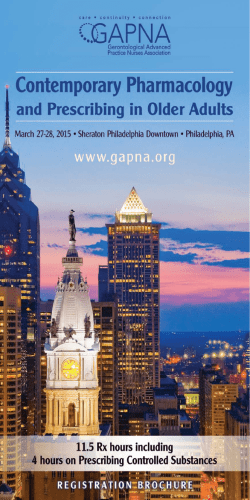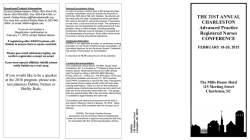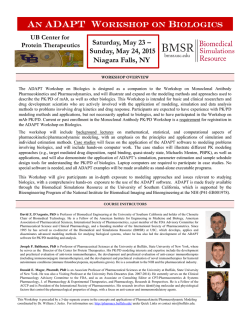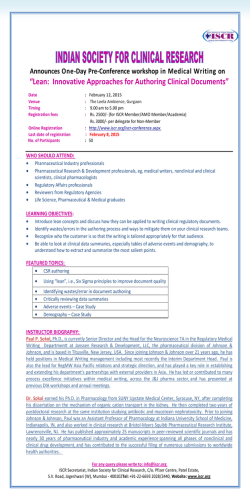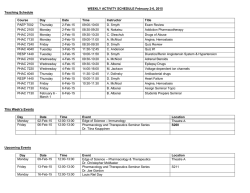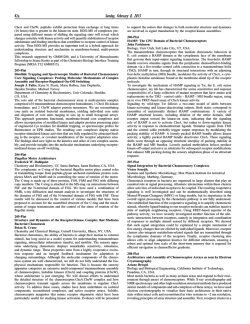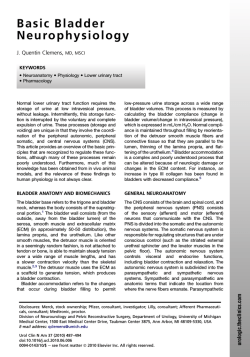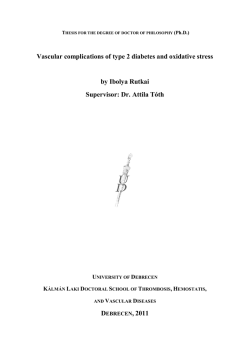
NC-IUPHAR newsletter - Guide to Pharmacology
ISSUE 06 JAN 2015 NC-IUPHAR news The biannual newsletter from the IUPHAR Committee on Receptor Nomenclature and Drug Classification and the team developing the IUPHAR/BPS Guide to PHARMACOLOGY (GtoPdb) A MESSAGE FROM NC-IUPHAR FEATURED Database update p.2 Profile: GPCRDB p.3 Patents as a data resource p.4 Parallel Worlds of Chemistry Data p.7 Social Media Update p.8 Conferences & Meetings p.9 NC-IUPHAR October 2014 Meeting Report p.11 Recent Publications p.15 As many of you will be aware, and as announced at the hugely successful 17th World Congress of Basic and Clinical Pharmacology (WCP2014) in Cape Town, South Africa, Michael Spedding (the outgoing Chair of NC-IUPHAR) has taken up the role as Secretary General of IUPHAR. Sam Enna is now President of IUPHAR. More information on the new IUPHAR Executive Committee for 2014-2018 can be found in the December issue of "Pharmacology International", the newsletter of the International Union of Basic and Clinical Pharmacology (IUPHAR), is now available for download at http://www.iuphar.org/pdf/Pharmacology_International_2014_December.pdf. NC-IUPHAR and the IUPHAR/BPS Guide to PHARMACOLOGY database (GtoPdb; available at http://www.guidetopharmacology.org/) offers a unique and complementary approach to those taken by, for example, the European Bioinformatics Institute (EBI), because GtoPdb contains published information reviewed by the NC-IUPHAR expert committees. These experts consider features beyond the capability of machine-based data trawling, such as what we know and don’t know, variables affecting drug receptor affinity, the crucial challenges of multiple gene products, and can make recommendations in alternative splicing, epigenetics, allostery, disease and drug ontologies. The committees also consider how best to communicate these issues. NC-IUPHAR has grown massively over a quarter of century, and the cumulative H-Index for NCIUPHAR publications is now 72. The recent (non-contentious) classification of transporters and the complete pharmacology of kinases in GtoPdb have been achieved in very short periods of time (~1 year). However, this massive effort now requires different ways of management and Michael, as outgoing chair, wants to involve all IUPHAR in this initiative, in a world-wide effort. However, ambitious goals also require appropriate budgets and revised management structures in a bigger organisation. Thus, a major review of the structure and running of NC-IUPHAR is being undertaken by a newly formed NC-IUPHAR Strategic Review Committee. The remit of this committee is to review the current status of NC-IUPHAR and its activities, and recommend a path/model for going forward. These recommendations will be finalised at the upcoming NC-IUPHAR meeting in April in Edinburgh, Scotland. There will no doubt be some changes to the format and running all NC-IUPHAR’s activities, but foremost is in our minds that is that NC-IUPHAR, through its fruitful collaboration with the British Pharmacological Society (BPS), will remain fully committed to supporting innovative drug discovery and developing the GtoPdb portal, an authoritative and freely accessible, global online resource. Also, the unique advantage is a world-wide network of experts, so your help is much appreciated, and can change pharmacology. WCP2014 was a fabulous meeting, and both NC-IUPHAR and GtoPdb featured prominently in the programme, including seven plenary lectures and 12 symposia presented by NC-IUPHAR members and affiliates, as well as live demos of the database at the BPS stand. A major drive is now underway to promote the database and NC-IUPHAR activities in collaboration with the Japanese (at their upcoming 88th Annual Meeting in Nagoya; http://www.congre.co.jp/jps88/english/index.html), Chinese and Australian (at the upcoming Joint ASCEPT-BPS Scientific Meeting I Hong Kong; http://asceptbps2015.com/), and Indian (at their 47th Annual Conference in Gumahati , 2014; http://www.ipsconguwahati2014.org/index.php) Pharmacological Societies, as well as PharfA, the IUPHAR ‘Pharmacology for Africa’ initiative. A full update from the database team can be found on Page 2 of this newsletter. We wish you all a successful 2015! 01 An expert-driven guide to pharmacological targets and the substances that act on them. The IUPHAR/BPS Guide to PHARMACOLOGY (GtoPdb) is an open-access database with expert-curated summaries on a wide range of targets of approved and experimental drugs. It covers the key properties of each target family, nomenclature, selective ligands, and recommended background reading. More detailed information is provided for a subset of important targets. NC-IUPHAR oversees the development of the database, and its network of >650 international scientists contribute information and review the data. Some developments since the July 2014 newsletter… IUPHAR-DB.org now redirects to GuidetoPharmacology.org The old IUPHAR-DB website is no longer being developed and all pages on this site now redirect to the corresponding entries in GtoPdb. GtoPdb website updates New features on the website include a new auto-complete function when entering query terms in the database search box – clicking on matched entries takes you directly their database page. Under target family lists, each family in the hierarchy can now be given its own overview page; to access these click on the ‘Overview’ icons (e.g. see ‘Peptidases and proteinases’ in the Enzyme list as an example). FAQ We have created an FAQ page which provides additional background information not covered by the Help page (www.guidetopharmacology.org/faq.jsp). New download formats • We have supplemented our downloadable ligand CSV file with another file specifically for the ~2000 endogenous and synthetic peptides in the database, containing single letter and three letter sequences, post-translational and chemical modifications. • The full relational database is now also available to download in MySQL format. If you download and use this file, or the original PostgreSQL database, please do let us know. Database updates • GPCRs: Class Frizzled GPCRs, Lysophospholipid (LPA and S1P) receptors, Melaninconcentrating hormone receptors, Melatonin receptors, Neuropeptide FF/neuropeptide AF receptors. • VGICs: Inwardly rectifying potassium channels, Voltage-gated calcium channels, TwoP potassium channels, Voltage-gated potassium channels, Voltage-gated sodium channels. • Enzymes: Kinases: curation of all phase III kinase inhibitors; Proteases: new ligand mappings including clinical candidates and lead compounds. • Ligands: Added repurposing compounds from NCATS, AstraZeneca Open Innovation and other sources. Database statistics Target class 7TM receptors G protein-coupled receptors including orphans Orphan G protein-coupled receptors Other 7TM proteins Nuclear hormone receptors Catalytic receptors Ligand-gated ion channels Voltage-gated ion channels Other ion channels Enzymes Transporters Other protein targets Total number of targets Chemical class Synthetic organics Metabolites Endogenous peptides Other peptides including synthetic peptides Natural products Antibodies Inorganics Others Approved drugs Withdrawn drugs Drugs with INNs Labelled ligands Total number of ligands Number of binding constants Number of references Number of targets 394 388 129 6 48 240 84 141 47 1138 508 108 2708 Number of ligands 4415 583 730 1174 217 67 34 8 1176 61 1691 580 7220 42916 24869 Latest content statistics are available on the right hand side and on the GtoPdb About page. 02 PROFILE ABOUT THE AUTHOR GPCRDB: GPCR data, diagrams and tools David E. Gloriam, Ph.D. Department of Drug Design and Pharmacology University of Copenhagen Jagtvej 162, 2100 Copenhagen David Gloriam is the head of GPCRDB and Associate Professor at the University of Copenhagen. He received his Ph.D. in Medicine from Uppsala University in 2006 on the topic of bioinformatic identification of G protein-coupled receptors. This was followed by postdoctoral stays at the EMBL European Bioinformatics Institute and GlaxoSmithKline, UK where he developed new data standards and computational drug design techniques. In 2008, David joined the University of Copenhagen where he has used computational methods to identify new receptor ligands. David’s passion for GPCR modelling is clear from the recent international GPCR Dock competition, where his group ranked first for the serotonin 5HT1B receptor model and third for its ligand complex. David has authored thirty-eight peer-reviewed papers and one book chapter. Recently, his group took over the leadership of GPCRDB and published a set of new data and tools enabling the GPCR community. In December David also received an ERC Starting Grant to work on orphan receptors and the GPCRDB. G protein-coupled receptors (GPCRs) make up the largest membrane protein family and regulate a plethora of physiological processes ranging nervous and endocrine systems and sensation of odours, taste and light. They constitute the targets of roughly 30% of the marketed drugs, although so far only a few of the receptors have been exploited therapeutically. The GPCR database, GPCRDB (gpcrdb.org), was started by Gert Vriend, Ad IJzerman, Bob Bywater and Friedrich Rippmann in 1993. At this time a growing number of receptor sequences were identified through gene cloning, and as web browsers had not yet been introduced, GPCRDB was originally an automatic email answering system that could send sequences, alignments, and homology models. Over two decades, GPCRDB evolved to be a comprehensive information system storing and analysing data. In 2013, GPCRDB was transferred to the University of Copenhagen, backed up by a EU COST GPCR Action ‘GLISTEN’. In this process, the database has transformed from being mainly a bioinformatician’s resource to target a multidisciplinary audience. This has involved the release of new user-friendly data, diagrams and tools; and cross-referring with major complementary databases including the IUPHAR/BPS Guide to Pharmacology. 1. Receptor residue diagrams Side-view - Snake plot Among the most popular and recognised features in GPCRDB are the receptor residue diagrams; snake-plots and helix box diagrams (Fig. 1). These are often used to visualise the topological position of receptor mutants. The diagrams can automatically highlight in vitro mutants stored in GPCRDB, or swiftly be custom-coloured for illustration of unpublished mutant effects; and downloaded for publication/presentation. As an open archive, GPCRDB allows researchers to voluntarily contribute published mutagenesis data to increase its dissemination and compare it to previously reported data. In recent years, technological breakthroughs have led to an exponential increase in the number of GPCR crystal structures. The first structure of a ligand-activated receptor, the β2-adrenoceptor, was presented in 2007 by the Nobel laureate Brian Kobilka and today, more than 110 structures have been reported for 26 unique GPCRs (Fig. 2). 03 As a result, many researchers have lost track of the available structures, and it is increasingly difficult to find which is the most relevant template for the target of interest. To this end, GPCRDB has made available a crystal structure browser with filters for manually curated ligand and receptor data and target-template sequence similarity measures. Upon selection of multiple crystal structures (or uploaded models), an optional tool can superpose them on the overall structure or sub-site residues, e.g. lining a common ligand-binding pocket, in the transmembrane domain. Despite of the significant progress, structures are still only available for 26 out of the ~350 non-sensory receptors, and a lot more insights and opportunities are expected to follow soon by the coverage of new receptor families and signalling protein complexes. GPCRDB aims to work together with the structural biology and structure-based drug design communities in this exciting time to make the most of this data and to development related tools. 2. No. GPCR structures by year and ligand type GPCRDB holds all UniProt GPCR protein sequences, more than 60.000 unique receptors (orthologues), and correct alignments is a pre-requisite for many studies on receptor mutants, ligand-binding residues and functional structural microdomain. Consequently, GPCRDB has released (crystal) structure-based sequence alignments that are unique in that they take into account structural distortions, bulges and constrictions, in the transmembrane helices so that spatially equivalent residues aligned in a structural comparison are also the ones aligned in sequence. This includes cross-class sequence alignments, allowing for studies of conserved motifs of the GPCR machinery. This was made possibly only by the recent advent of a crystal structure of a member in each class that can function as a ‘Rosetta stone’ in the structural alignment. GPCRDB alignments feature residue conservation statistics for the 20 individual amino acid types as well as property groups, such as hydrophobicity, charge and size. The alignments can be matched against a user-defined sequence motif to retrieve a given profile of targets that share for example a ligand binding site or functional structural microdomain. Finally, receptor relationships can swiftly be depicted as phylogenetic trees (Fig. 3). GPCRDB is in the process of migrating to modern web technologies that are independent of third party web browser extensions. The new interface uses HTML5 technologies (including CSS3) and JavaScript to provide a responsive user experience. Scalable vector graphics (SVG) are used to generate interactive diagrams that can be downloaded in high resolution for publications. The data is stored using the MySQL database engine, and the Apache web server is used to serve the web pages to the users. GPCRDB offers SOAP web services for programmatic access, and is working towards making more content dynamically accessible by other web sites. 3. Receptor relationships as phylogenetic trees Circular Ladder In conclusion, GPCRDB aims to enable researchers by providing easy access to key experimental and derived data, visualise relationships and to provide easy-access analysis tools. As a specialised database it goes in-depth and combines heterogeneous data with an added layer of curated information. One of the plans for the close future is to provide annotated ligand-interactions from GPCR-ligand crystal structure complexes side-by-side with the receptor mutants to give a structural explanation of the observed pharmacological effects. The GPCR field and GPCRDB have experienced fundamental changes during the past twenty years, and the database intends to grow with and to inspire further scientific progress in the future. 04 Exploiting patents as a data source in GtoPdb By Christopher Southan While we all appreciate a good journal paper, wading through hundreds of pages of turgid legalese in a patent is not most scientists’ idea of an enlightening read. Nonetheless, even for those pharmacologists not engaged in filing patents themselves, there are good reasons (listed below) not to overlook them as a useful data source. 1. In terms of published medicinal chemistry, the proportion in patents exceeds that in papers by anything from two to five-fold (depending on what entities or data types are being counted). 2. They typically appear 2-5 years before the related paper that may include only a subset of the same data. 3. Inventor teams, from pharmaceutical companies or academic institutions, may be world-class. 4. Some high-quality result sets remain patent only. 5. PubChem contains over 15 million patent-extracted chemical structures and SureChEMBL has 15 million (including ~ 6 million not yet in PubChem). 6. Patent documents are indexed for searching in many open portals, including as full-text, within days of publication. The problem is that patent mining has many associated challenges that make it tough going, even for those adept at literature searching. The good news is that GtoPdb is doing the hard work for you in certain value-added cases (see our FAQ). While coverage is not high, we selectively reference patents in ligand entries for a) more recent leads or development drug candidates b) where results including more high-potency analogues than the paper c) we can “bind” a structure to its location in the document, and d) cases where the only published SAR is from a patent. As an example of the latter, for the putative diabetes drug target BACE2 is shown below where ligand 7853 was curated from Roche’s patent WO2010128058. The utility is that it not only links a 6 nM inhibitor to example 20 in the document but also includes IC50s (many sub-100 nM) for 129 additional defined chemical structures from the SAR table (as shown below). The work we put in includes binding in the sense of mapping an example number with an activity result in the patent (e.g. no. 20 as the highest potency in the table above) to the explicit structure that has converted to a database record and surfaced in PubChem. Note also that the synthesis of all the examples is described in the patent. We typically use SureChEMBL as the source for the extracted structures but can also determine these ourselves (e.g. in cases where automated image or IUPAC text conversion fails) using OSRA and chemicalize.org As you can see below our link is then added into the PubChem compound record (CID). 05 This completes a virtuous circle where the GtoPdb ID, patent number, example number, IC50, PubChem CID, the SureChEMBL pointer and the InChIKey (searchable in Google) are now all connected (and note we add the target mapping to boot). Since one of our criteria for curating a patent connection is useful SAR content, there are a number of ways that you can compile the complete set of structures and map these to the results (e.g. for building pharmacophore models). These can only be outlined here but those with a strong interest in doing this from one of our ligand entries are welcome to contact us. Firstly, you can quickly see if at least some of the analogues from the same document are in PubChem at al by looking at the “similar compounds” connectivity. In this case you can see 21 nearest neighbours that are clearly from the same series. The second approach is to use SureChEMBL for a complete download of the structures extracted from the document. In this case 224 structures are retrieved but these need a few tricks to be filtered down to just the 130 from the result table. Thirdly, if a US patent number is indexed in the PubChem record, these may retrieve as a clean set, as shown below. Fourthly, there is usually no way round the manual steps of aligning the data values against the 130 structures (unless you choose one of the patents extracted by BindingDB) Last but not least, note that for any of our ligand entries with a CID, you can follow up patent links on your own, regardless of whether we have selected one. The two easiest ways are a) check the CID record for patent indexing by PubChem and b) search the structure in SureChEMBL. While there are caveats as to the value of patents you may find in this way, a useful rule of thumb is to look for a match between the assignee and inventors on the patent to the affiliation and authors on the paper (e.g. the same pharmaceutical company and at least some names in common). Certainly for leads, development compounds and newer drugs, your chance of finding a relevant match is very high. However, the probability you can extract significantly more SAR than from the patent compared to the literature reference we have already curated for you is somewhat lower. If you do come across cases you find useful (e.g. of just a few leads in the paper but hundreds of analogues with reasonable potency in the patent), particularly from patents published in the last few years, please let us know. 06 FEATURED PUBLICATION: THE PARALLEL WORLDS OF CHEMISTRY DATA by Christopher Southan Interactions between members of the GtoPdb team and collaborators can result in co-authorships. We have chosen to highlight a recent paper that included team member, Chris Southan, because it adds context to both GtoPdb and the larger chemical database ecosystem that it is part of. Chris was encouraged to contribute to this paper (PMID 25415348) by Sean Ekins and Antony Williams with whom he had published previously (PMID 23159359). Those of you familiar with “Lipinski's rules” (e.g. as specified in our own ligand chemical property computations) will doubtless also recognise the first author. The paper has been well received, including being awarded the F1000Prime red badge you can see on the right, and also featuring on the esteemed In The Pipeline blog. One of the points made in this review is the sheer number of bioactive chemical structures in the public and commercial databases. This may come as a surprise to those not used to searching and navigating much beyond the ~7000 well characterised and annotated pharmacologically active substances that we capture. The largest individual collection is the commercial SciFinder resource with 91 million organic and inorganic substances (the team has access via a University of Edinburgh subscription). Notwithstanding, the public UniChem database at the EBI is catching up at 87 million, PubChem weighs in at 63 million and ChemSpider has 33 million entries (the latter two have been reviewed in previous editions of the newsletter). The problem faced by anyone asking the simple question “what is out there that is similar to my chemical structure of interest” is that each of these three has an unknown proportion of unique content. Searchers are thus presented with a de facto three-stop-shop (n.b. as explained in the paper, SciFinder does not capture everything either). Understandably we neither have the time to perform such three-stop-shop searches as part of our usual curation triage nor as a service for users (but the FAQ does describe how you can navigate the pre-computed similarity results in PubChem). Nevertheless, if you have data linked to what may be a novel or unusual chemical structure in your own publication and you think this could be included in GtoPdb, you are welcome to contact us regarding broad searching (n.b. if you do not have access to J Med Chem you can send a request to cdsouthan at Hotmail dot com to receive a PDF). 07 JOINING UP THE SOCIAL MEDIA DOTS: WHAT YOU CAN DO TO HELP by Helen Benson In order to enhance our outreach the database team has been optimising use of various social media channels (SMCs). We cannot go in to the subject in detail but this form of profiling in science is changing rapidly and is long past the point where engagement was optional for an operation like ours. Every major database we interact with now has a Twitter tag as well as many of their team scientists being active as individuals. These presences are increasingly multiplexed on LinkedIn, Facebook, G+, SlideShare and Figshare and others. Altmetrics is a useful tool which tracks mentions of papers on SMCs and blogs as well as their depositions in open reference sharing repositories such as Mendeley and CiteUlike. We currently maintain profiles on Facebook, Twitter, LinkedIn, SlideShare, CiteULike (where we share and annotate papers for new database content) and a WordPress blog. The team have also started using PubMed Commons to “connect” between our affiliated papers, IUPHAR reviews, database features and blog posts (it is also very useful for forward citations). A selection of our activity is shown below (in order: WordPress, Twitter, LinkedIn, SlideShare, PubMedCommons). 08 You can help us in the following ways (these are merely suggestions of course but note SMC has an element of reciprocity in that your chosen linking behaviours enhance your own scientific/professional profile) FOCUSED MEETING: EXPLOITING THE NEW PHARMACOLOGY AND APPLICATION TO DRUG DISCOVERY 20 —21 April 2015 Royal College of Physicians, Edinburgh 1) Follow us on Twitter and re-tweet where you think this is relevant to your followers (“favouriting” is OK too). We tend not to get into replies but it is an option. Note if your tweet stream is pharmacologically orientated we are likely to follow-back and probably re-tweet some of your posts (e.g. a link to your latest paper) 2) LinkedIn: in the first instance you can connect with us and other newsletter readers such as NC- IUPHAR committee members (those you know personally). Should you then choose to “like” one of our posts this flashes on your own network. The cumulative reach of this becomes substantial and can lead to genuine expanded connectivity. Here again this becomes reciprocal (e.g. you announce your latest paper and we “like” it) 3) Facebook: Likes are useful to increase our ranking. CONFERENCES and WORKSHOPS Attended by the Database team KEYNOTE SPEAKERS: Sir Colin Dollery (GlaxoSmithKline, UK) Bill Catterall (University of Washington, USA) The focus will be on new concepts and developments in pharmacology and how they can be exploited in drug discovery including: new strategies for targeting calcium channels, tyrosine kinases, microRNAs, epigenetics, new developments in monoclonal antibodies, allosteric modulators, biased signalling, receptor structure. The meeting will include invited expert speakers, contributed free communications and poster presentations, with prizes for young investigators. http://www.bps.ac.uk/meetin gs/NewPharmaDrugDiscover y In July, Adam Pawson and Chris Southan attended the World Congress of Pharmacology 2014 in Cape Town, South Africa. In August Michael Spedding represented the team at the "Protein bioinformatics and community resources retreat" held at the Wellcome Trust Genome Campus, Hinxton, Cambridge. The meeting brought together the developers of several protein databases. In September Helen Benson attended a meeting at the University of Reading on Quantitative Nutrition and Metabolism at which the role of databases in Systems biology and systems pharmacology were discussed. Joanna Sharman attended a workshop on web services in Nijmegen, The Netherlands, organised by GPCRDB. October was a busy month for the database team. Adam Pawson, who attended GLISTEN/GPCRDB Conference in Budapest 2014, database developer Joanna Sharman, who joined the Clinical Genomes Scotland Meeting in Edinburgh, and Elena Faccenda, who attended the RSC CICAG What's in a Name meeting, RSC in London. In November curators Helen Benson and Elena Faccenda attended the Elixir UK Data Carpentry workshop held at the University of Manchester, which included training in basic bioinformatic techniques. In December, Members of NC_IUPHAR took part in the BPS Pharmacology 2014 meeting. In January 2015 workshop at the European Bioinformatics Institute on best practices in Javascript. 09 About NC-IUPHAR The Concise Guide to The IUPHAR Committee on Receptor Nomenclature and Drug Classification (NC-IUPHAR), founded in 1987, is chaired by Michael Spedding (France). NC-IUPHAR has the objective of issuing guidelines for the nomenclature and classification of all the (human) biological targets, including all the targets of current and future prescription medicines; facilitating the interface between the discovery of new sequences from the Human Genome Project and the designation of the derived entities as functional biological targets and potential drug targets; designating polymorphisms and variants which are functionally important; developing an authoritative and freely available, global online resource, the IUPHAR database, which is now accessible via the Guide to PHARMACOLOGY portal (http://www.guidetopharmacology.org), with a remit to provide access to data on all known biological targets; enable students and scientists in academia and industry, working in areas related to pharmacology and drug/target research, to exploit the full potential of the considerable amount of information on drug action available in the published literature; provide an entry point into the pharmacological literature for basic and clinical scientists from other disciplines; provide an integrated educational resource with access to high quality training in the principles of basic and clinical pharmacology and techniques; foster innovative drug discovery. Membership Chair Michael Spedding, France Vice Chairs Anthony Davenport, UK Chairman Evolving Pharmacology Group Rick Neubig, USA - GPCRs Eliot Ohlstein, USA - Editor Members Stephen Alexander, UK Thomas Bonner, USA William Catterall, USA Arthur Christopoulos, Australia John Cidlowski, USA Sir Colin T. Dollery, UK Doriano Fabbro, Switzerland Kozo Kaibuchi, Japan Yoshikatsu Kanai, Japan John Peters, UK Alex Phipps, UK Jean-Philippe Pin, France Corresponding members Susan Amara, USA Michel Bouvier, Canada Thomas Burris, USA Stephen Charlton, UK Moses Chao, USA Steven L. Colletti, USA Graham Collingridge, UK Sue Duckles, USA Richard Eglen, UK Steven Foord, UK David Gloriam, Denmark Gillian Gray, UK Debbie Hay, New Zealand Allyn Howlett, USA Franz Hofmann, Germany Yu Huang, Hong Kong For more information about NC-IUPHAR please visit: http://www.guidetopharmaco logy.org/nciuphar.jsp Corresponding members contd… Ad P. Ijzerman, The Netherlands Michael F. Jarvis, USA Bong-Kiun Kaang, Korea Terry Kenakin, USA Janos Kiss, Hungary Chris Langmead, Australia Vincent Laudet, France Margaret (Mandy) MacLean, UK Fiona Marshall, UK Alistair Mathie, UK Ian McGrath, UK Graeme Milligan, UK Stefan Offermanns, Germany Richard Olsen, USA Helgi Schiöth, Sweden Graeme Semple, USA David Searls, USA Roland Staal, USA Bart Staels, France Georg Terstappen, Germany Mary Vore, USA Past Chairs (ex officio) Paul Vanhoutte, China Robert Ruffolo, USA Ex Officio Sam Enna, USA - IUPHAR President Michael Spedding, France - IUPHAR Secretary-General Petra Thürmann, Germany - IUPHAR Treasurer Simon Maxwell, UK - Educational Site Project Leader Jamie Davies, UK - Database Principal Investigator Joanna Sharman, UK - Database Developer Adam Pawson, UK - Senior Database Curator Helen Benson, UK - Database Curator Elena Faccenda, UK - Database Curator Christopher Southan, Sweden - Chemical Curator Veronika Divincova, UK - Project Administrator Elspeth Bruford, UK - representing HGNC PHARMACOLOGY 2013/14 • Concise overviews of the key properties of over 2,000 targets with pharmacology • Links to open access knowledgebase of drug targets and their ligands (www.guidetopharmaco logy.org) • Official IUPHAR classification and nomenclature for human drug targets • Easy to use tables comparing related targets • Produced in conjunction with NC-IUPHAR • Direct links from gene symbols and UniProt IDs to corresponding entries in HGNC and UniProt • Recommended further reading with direct links to citations in PubMed • Permanent, point-intime record that will survive database updates • Now available at: http://www.guidetopha rmacology.org/concise Clinical Translational Pharmacology Group (core member Sir Colin Dollery) Ed Bullmore, UK Robert Dow, UK Garrett Fitzgerald, USA Alex Phipps, UK Patrick du Souich, Canada David Webb, UK Don Birkett, Australia 10 NC-IUPHAR Meeting Report ,October 2014 Organisation OCTOBER 2014 ATTENDEES Michael Spedding Anthony Davenport David Gloriam Bill Catterall Colin Dollery Graeme Henderson Ian McGrath Francesca LeviSchaffer Eliot Ohlstein Arthur Christopolous Steve Alexander Sam Enna Jono Bruun John Cidlowski Doriano Fabbro Marie-Paule LeFranc Ana Rath Marie-Pierre BecasGarro Lilian Lau Antonia Gaurot Ralf Jockers Benita Sjogren (Neubig Lab) Thierry Wurch Paul Vanhoutte Tom Burris (via phone) Database team Jamie Davies Joanna Sharman Adam Pawson Helen Benson Elena Faccenda Chris Southan NC-IUPHAR has grown massively over the last quarter century to become a major international organisation (H-index 72) and while this growth shows that the process of having two NC-IUPHAR meetings/year, 80 subcommittees and a database is highly effective, it is impossible for a single chair to keep on top of everything. Furthermore, this growth has occurred with Michael Spedding (Chair) having regular telephone updates with Tony Harmar (Database Chair), but the death of Tony, and the election of Michael to be secretary general IUPHAR force changes. Michael Spedding has written up a document of propositions, and a committee chaired by Doriano Fabbro, Adam Pawson, Steve Alexander, Arthur Christopoulos will make a series of propositions to IUPHAR in January 2015. Below is a summary of discussions that took place at the meeting around various NC-IUPHAR initiatives. Funding A major effort has been put into new grants applications and the interaction with the BPS for a sustained effort for sources of funding for the IUPHAR/BPS Guide to PHARMACOLOGY database (GtoPdb) and IUPHAR. Hinxton database Meeting Michael Spedding presented a report on this meeting uniting the main protein databases. A clearly important issue is that the one gene one protein concept is wrong and this provides us a major way forward. What we achieved at the World Congress of Pharmacology 2014 in Cape Town, South Africa - Plan for IUPHAR and also for continuation of NC-IUPHAR. - Creation/integration of pharmacology (and societies) throughout Africa, with a common voice, PharfA. The IUPHAR database (IUPHAR-DB) which is now “www.guidetopharmacology.org” (GtoPdb) and which describes most of the drug binding sites in the human genome is already the main scientific output of IUPHAR. The Chinese, Japanese, Indian, Australian societies will promote it actively. The incorporated social networks will used to integrate individual African scientists in their development (PharfA). The IUPHAR/ASPET education website is physically complete and will now be filled with content. Revision of the organisation of IUPHAR, to become a truly influential organisation by issuing key recommendations for world heath care. Examples of potential IUPHAR proposals How to support drug discovery and development for rare and tropical diseases, IUPHAR editor. Databases - Create an IUPHAR landing page for IUPHAR site, GtoPdb, IUPHAR/ASPET education site, IUPHAR sections. Rapid action with web page experts. - GtoPdb is the main resource for pharmacology science worldwide. Provide short PPT presentations to exec comm members for diffusion of GtoPdb in Japan, China. Graeme Henderson will visit India (end Dec/Jan). Consider social media for support to Africa. Antibodies Subcommittee: Michael Spedding, Thierry Wurch (Servier), Marie-Paule Lefranc (IMGT database (http://www.imgt.org) Alex Phipps (Roche), Francesca Levi-Schaffer (IUPHAR Immunopharmacology Section), potentially Janice Reichert (Antibody Society). Regular teleconferences now taking place. An update was presented by Marie-Paule Lefranc and Thierry Wurch. We will NOT participate in antibody nomenclature as this is clearly defined at present but will write a background article on it. Innate Immunopharmacology : Pattern receptors (PRRs) Clare Bryant has agreed to chair a subcommittee. She has identified two colleagues (Tom Monie and Brian Ferguson) who have assembled a review for Pharmacological Reviews. Describe the different families of PRRs, how they signal and their function: this will include terminology Discuss the current appropriate genetic data linking PRRs to disease as a means of identifying therapeutic targets. Discuss the pharmacology of these receptors: how they signal and how they could be targeted- this will include currently available compounds and future prospectives. Review submitted. 11 NC-IUPHAR Meeting Report, October 2014 (continued) Epigenetics Subcommittee Chair: Rab Prinjha; Members: David F. Tough, Huw D. Lewis, Inmaculada Rioja, Matthew J. Lindon An excellent IUPHAR Review has been published in BJP, which has been very well received. The chair stated that this is exactly what IUPHAR should be doing – up to date articles on the key issues in pharmacology. The database has been updated with all targets and ligands from the review in preparation for full annotation with guidance from the subcommittee we also plan to add the ligand > target mappings from review tables along with associated references. Kinases Subcommittee chair: Doriano Fabbro (FLT3, KIT, PDGFR); Members: David Gray, Peter Norman, Elena Faccenda Other suggested members: Georg Martiny-Baron (VEGFR, EPHs), Kurt Ballmer (VEGFR) Invited to be members: Bill Zuercher (GSK) and Michael Eck (DFCI) for EGFRs. IUPHAR Review submitted to BJP (“10 things a pharmacologist should know about kinases”), which received the congratulations of the chair. Kinases and Immunopharmacology/orphan diseases, Wellcome grant Because we have all the kinases in GtoPdb, it was decided during the meeting that the kinases involved in immunology/inflammation and in orphan diseases will form the basis of a new Wellcome grant (PI Jamie Davies), which has now been submitted. The chair, Francesca LeviSchaffer and Doriano Fabbro have thus subsequently had a series of telephone calls with influential UK immunopharmacologists who have all agreed to form an editorial group, and to support these activities. These are: Luke O’Neill, Iain McInnes, Steve Anderton, Clare Bryant, Keith Peters, Tracy Hussell. Steve Holgate and the British Immunopharmacological Society will be contacted. The set of kinases involved in orphan diseases will also be included (Anna Rath, Orphanet). Proteases Subcommittee chair: Anthony Turner; Members: David Fairlie, Neil Rawlings, Christopher Southan The database now includes pages with genomic and structural information for 175 proteases and 14 hydrolases with activity records in ChEMBL. Detailed ligand activity (Ki or IC50) mapping has been curated for 46 proteases and 14 hydrolases for either approved prodrugs, drugs, clinical candidates or selected research compounds. Clinical candidates and research compound mappings can be extended for these classes, depending on overall priorities for target expansion. This topic will be covered in detail at the Edinburgh meeting. GPCRs New subcommittee chairs: Ralf Jockers (Melatonin), Deborah Segaloff (Glycoprotein hormone), Xavier Norel (Prostanoid), Jean-Pierre Vilardaga (Parathyroid hormone). Ralf Jockers gave an excellent talk on the current status of melatonin receptors and their potential heterodimers. He was warmly congratulated by the chair. Ralf also runs the French Groupe de Recherche (GDR) on GPCRs. This year the NC-IUPHAR Paris meeting and the GDR meeting could not coincide – we will try and ensure that the meetings are back-to-back in October 2015 and 2016. Arthur Christopoulos gave an excellent overview of biased signalling, which will form the basis of the October 2015 Paris meeting. His IUPHAR allosteric document has just been published in Pharmacological Reviews. RGS proteins Subcommittee chair: Benita Sjogren; Benita, representing Rick Neubig, gave a presentation on the role of RGS proteins. A group of experts has been recruited and they are working on a database template for RGS proteins. Transporters Chair: Steve Alexander; Members: Mary Vore, Susan Amara, Yoshikatsu Kanai; Matthias Hediger to advise. Kathleen Giacomini and the UCSF-FDA TransPortal (http://bts.ucsf.edu/fdatransportal) synergy potential? Subsequently contacted and positive. MS and SA have subsequently contacted the president of ISSX, John Miners, for a joint collaboration as ISSX have immense experience in transporters and metabolism but no website – a synergy could have immense benefits. Proposition submitted for the January ISSX meeting. The Concise Guide to PHARMACOLOGY The Concise Guide to PHARMACOLOGY is the result of the unique IUPHAR/BPS collaboration. The next Concise Guide to PHARMACOLOGY 2015/16 will be published in Autumn 2015 A rolling programme of updates to the concise summaries in the database has now been implemented in preparation for the next edition of the Concise Guide. 31st July 2015 deadline for next edition (i.e. to go to typesetters) Priority list for filling out concise pages (overviews, further reading, etc.) for new targets. Process of updating entries. Dealing with kinases and proteases. New entries (~6 new families). Highlighting current errors and improvements to functionality. Improving automation from the database. We are working with Peter Buneman (University of Edinburgh) to improve the process of producing the documents directly from the database. IUPHAR/ASPET Pharmacology Education Project (PEP). An educational website with close links to GtP wand access to high quality training in pharmacological principles and techniques ASPET have provided funding for a part-time curator/web developer Simon Maxwell is leading the project in Edinburgh, with John Szarek co-chairing on behalf of ASPET. Simon and John have appointed an Editorial Board. The name has been agreed as IUPHAR/ASPET Pharmacology Education Project (PEP). A website domain name is yet to be finalised and purchased. 12 NC-IUPHAR Meeting Report, October 2014 (continued) Non-coding RNAs Subcommittee: Matt Wright, Sam Griffiths-Jones, Andrew Baker, Chair. BJP review introducing topic to pharmacologists (“10 things a pharmacologist should know about RNA”) was underway, collaborative writing via Google Drive. However, Matt Wright has left HGNC and the entire area is becoming extremely complicated. Decisions : Not to address in database. “10 things a pharmacologist should know about RNA” is still ‘a very good objective’ but low priority for the moment, the field is just too complicated and progressing too rapidly. Drug target and chemistry curation subcommittee Subcommittee chair: Christopher Southan; Members: Helen Benson, Edgar Jacoby, Michael Gilson, Arnaud Gohier, Chido Mpamhanga, Plamen Petrov, Roger Sayle, David Sharpe, Michael Spedding, Paul Thiessen. Remit: • Explore optimal reciprocal cross-pointing between resources • Ensure our chemical and peptide ligand entries (drugs in particular) are correctly and cogently annotated • Advising on general chemistry representational issues and difficult or ambiguous cases • Interact with authoritative chemical nomenclature groups (ICNTS (IUPAC), Pubchem, Royal Society of Chemistry, etc) • Critique any other aspects of the database (e.g. ease of navigation, link utility, minability, future-proofing) unique value addedcontent, etc.) • Informing of relevant updates in members’ domains, including those that might translate into new database entries • Ensure that subcommittees have chemical support for best quality ligands • Advise on consumability of the IUPHAR/BPS Guide to PHARMACOLOGY via downloads, API etc., for integration into customers’ internal systems Fulfilment of Wellcome Grant objectives. “To provide quantitative pharmacological information (QPI) on all of the (human) targets of approved drugs, and clinical and research targets” • Have reached QPI for 820 (777 Aug) proteins of which 300 (225 Aug) are primary targets of approved drugs • Estimate approved targets ~ 95% complete, 356 targets with clinical use comment • From the 1113 human proteins with interactions we will seek to extend quantitative data coverage. “To establish, for each drug target, a “gold standard” set of recommended pharmacological tools.” • 65% of our 5115 PubChem ligands pass a tool-compound sweet spot …continued • (Lipinski Rule of five + 150-800 Mw). c.f. ChEMBL 62%, DrugBank 68%) • 157 targets have 20+ ligands, 310 targets 10+ ligands It is a major objective of the Drug target and chemistry curation subcommittee to work with subcommittees on this issue Interactions with other resources Openphacts (IMI grant) • We have progressed our engagement with this major initiative via a series of TCs with the team • After our next release we will move on to concrete integration of entities in the first instance • This effort is in the vanguard of semantic queries across linked data, including the RDF’isation of data relationships • This gives us a great opportunity to engage with these powerful new approaches to data integration and mining • Note once we get integrated our content will then be utilised by OpenPhacts customers including GSK and Roche • The chair underlined that this is a major partnership for us Orphanet Ana Rath with Marie-Pierre Bécas-Garro gave an outstanding presentation on Orphanet and rare and orphan diseases and drugs. We can contribute in a major effort to link disease, target and drug ontology (a key IUPHAR objective). This is a major priority because there excellent synergies. A first step will be linking via the kinases. Follow up meeting with Orphanet in January. GPCRDB (Please see GPCRDB Profile on Page 3) David Gloriam gave an excellent presentation on the utility of GPCRDB and our interactions. We agreed that it is essential to have very tight links with GPCRDB and to have joint projects. Binding-DB • Subsequent to a visit from Michael Gilson (PI for BindingDB) in June we have extended our interactions via TCs • It transpires this database has both unique features and target > ligand content that we can utilize • Interactions to be reinforced European College of Neuropsychopharmacology ECNP (and all CNPs world-wide) A new psychiatry drug nomenclature has been launched for feedback with a well-developed app - this has the immense possibility of producing a more molecular approach to psychiatric disorders. However, some aspects of the nomenclature (particularly the abbreviations, which are not approved), require further work. Michael Spedding and Adam Pawson 13 EXPERT DRIVEN ANNOTATION The Guide to PHARMACOLOGY portal (which includes the IUPHAR Database) is maintained by a team of curators, with guidance from NC-IUPHAR and an international network of ~700 expert contributors, providing expert-driven annotation of the pharmacology of drug target systems from peer-reviewed primary literature sources. A global knowledge environment for pharmacology students, academic and industrial scientists, and the interested public. Subcommittees of NC-IUPHAR are responsible for developing the nomenclature for each drug target family and compiling data to be included in the database. Where no relevant subcommittee exists, data are captured by the curators or individual experts and peer reviewed by at least two external referees. Data are sourced from and referenced to the primary literature (peer-reviewed research publications rather than review articles), with links to citations in PubMed. Wherever possible, data are supported by more than one literature source. After review by the curators to ensure accuracy and consistency with the rest of the information in the database, the data are added to the development server. After approval by NC-IUPHAR, the data are transferred to the public database. Data are reviewed at regular intervals (at least yearly) by subcommittees and other contributors and updated as necessary. Our global network of expert contributors A full list of NC-IUPHAR subcommittee members and contributors can be view at: http://www.guidetopharmacology.org/GRAC/ContributorListForward 14 Recent publications The collaboration between NC-IUPHAR, the American Society for Pharmacology and Experimental Therapeutics (ASPET) and the British Pharmacological Society (BPS) allows NC-IUPHAR subcommittees to publish nomenclature reports in Pharmacological Reviews and ‘state-of-the-field’ reviews in British Journal of Pharmacology. A selection of the most recent NCIUPHAR related articles are listed below. Pharmacological Reviews British Journal of Pharmacology Kellenberger S, Schild L. (2015) International Union of Basic Beaulieu J-M, Espinoza S, Gainetdinov RR. (2014) Dopamine and Clinical Pharmacology. XCI. Structure, Function, and receptors: an update – IUPHAR Review 13 Br J Pharmacol. Pharmacology of Acid-Sensing Ion Channels and the Epithelial 2014 Oct 20. doi: 10.1111/bph.12906 [Epub ahead of print] Na+ Channel. Pharmacol Rev. 67: 1-35. Maguire JJ, Davenport AP. (2014) Endothelin@25 – new agonists, antagonists, inhibitors and emerging research Christopoulos A, Changeux J-P, Catterall WA, Fabbro D, frontiers: IUPHAR Review 12 Br J Pharmacol. 171: 5555–72. Burris TP, Cidlowski JA, Olsen RW, Peters JA, Neubig RR, Pin J-P, Sexton PM, Kenakin TP, Ehlert FJ, Spedding M, Tough DF, Lewis HD, Rioja I, Lindon MJ, Prinjha RK. (2014) Langmead CJ. (2014) International Union of Basic and Clinical Epigenetic pathway targets for the treatment of disease: Pharmacology. XC. Multisite Pharmacology: accelerating progress in the development of pharmacological Recommendations for the Nomenclature of Receptor tools: IUPHAR Review 11. Br J Pharmacol. 171: 4981–5010. Allosterism and Allosteric Ligands. Pharmacol Rev. 66: 918947. Other Journal Articles Lipinski CA, Litterman NK, Southan C, Williams AJ, Clark AM, Ekins S. (2014) Parallel Worlds of Public and Commercial Bioactive Chemistry Data. J Med Chem. 2014 Dec 4. [Epub ahead of print]. Southan C, Expanding opportunities for mining bioactive chemistry from patents. Drug Discovery Today. (in press) 15 Follow us on Social Media Guide to PHARMACOLOGY RSS feed http://feeds.feedburner.co m/GuideToPharmacology @GuidetoPHARM http://blog.guidetopharmac ology.org/ Developed with support from Our sponsors The database team Jamie Davies, database principal investigator; Edinburgh, Scotland From left to right; Veronika Divincova (project administrator), Elena Faccenda (curator), Joanna Sharman (database developer), Adam Pawson (senior curator) and Helen Benson (curator); Edinburgh, Scotland Chris Southan, cheminformatician/ curator; Göteborg, Sweden We welcome contributors! Although we already cover the majority of the targets of prescription medicines in the Guide to PHARMACOLOGY portal, there are a few important areas that we do not yet cover. We are seeking guidance from experts to help us curate and display more detailed information in the style of our more established target entries. If you would like to contribute your expertise to our effort, please get in touch with us at [email protected] ONGOING AND FUTURE NC-IUPHAR ACTIVITIES • Wellcome grant projects • Evolving Pharmacology – deorphanisation of GPCRs plus hot topics (web site); full list of GPCR orphans with • Allosterism (and functional coupling) – applied to GPCRs, ion channels, nuclear hormone receptors and kinases • Biased agonism and functional selectivity • GPCR heterodimers – standards and lists • Alternative splicing recommendations • Biomarkers • Target validation • Gene and protein lists for receptors and all drug sites coordinated between HGNC and NC-IUPHAR – with epigenetic consideration • Antibodies – collaboration with Marie-Paule Lefranc at IMGT • Interaction with the IUPHAR immunopharmacology section • Cyclases and Phosphodiesterases • Epigenetics, list of targets and pharmacological difficulties • Non-coding RNAs – with HGNC – list with pharmacological difficulties • Proteases and Hydrolases • Pattern recognition receptors • Transporters • Producing the Concise Guide to PHARMACOLOGY which replaces GRAC • The IUPHAR/ASPET Pharmacology Education Project 16
© Copyright 2026
